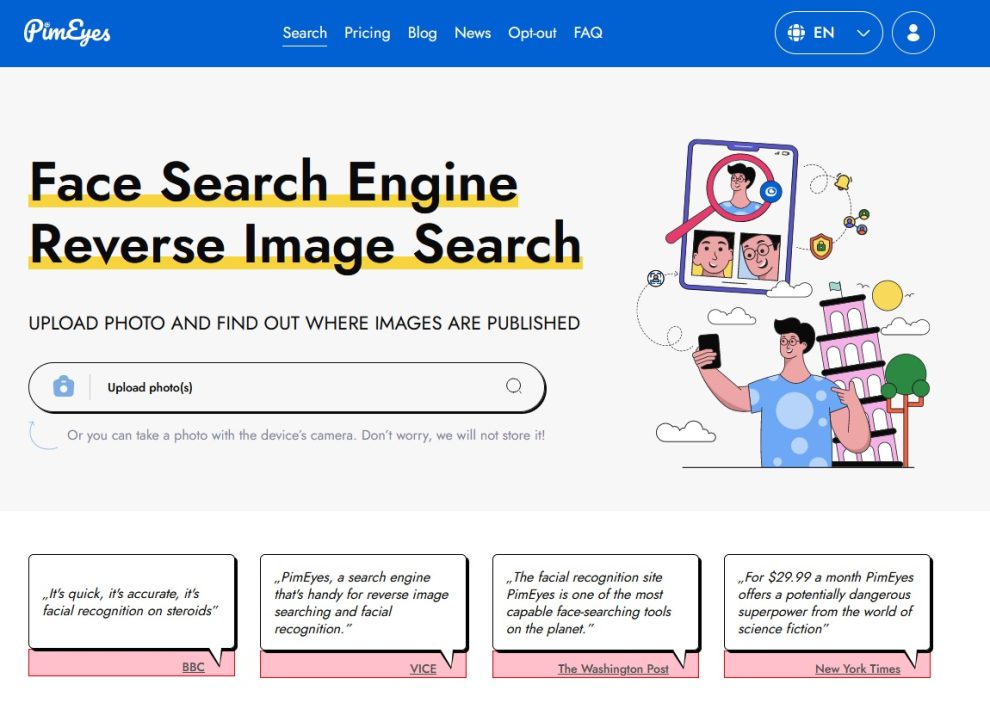Are you curious to discover more about the images and faces you come across online? Look no further than PimEyes, a cutting-edge tool that utilizes advanced facial recognition and reverse image search technology. With PimEyes, you can unravel the hidden details and information associated with an image or a face, providing valuable insights into the online presence of individuals.
In this article, we will delve into the features and benefits of PimEyes, exploring its powerful technology and usage for both personal and professional purposes. You’ll also learn about the ethical considerations surrounding image search and how PimEyes stands out from other facial recognition tools in the market.
Key Takeaways:
- PimEyes utilizes advanced facial recognition and reverse image search technology to uncover online presence associated with images and faces.
- With PimEyes, you can monitor where your images appear online and protect your online identity.
- The technology behind PimEyes involves sophisticated facial recognition algorithms that analyze key features of a face.
- Using advanced search techniques and customization options can enhance the accuracy and effectiveness of PimEyes searches.
- Comparing PimEyes with other facial recognition tools provides insights into its unique features and capabilities.
Understanding PimEyes and Its Capabilities
What is PimEyes?
PimEyes is an advanced search engine that specializes in facial recognition and reverse image search. It is a powerful tool that allows users to identify people in images, monitor their online presence, and track instances of their appearance across various platforms.
How Does PimEyes Stand Out from Other Search Engines?
PimEyes stands out from other search engines due to its cutting-edge technology and unique features. It utilizes sophisticated algorithms to provide highly accurate results in facial recognition and reverse image search. With its capabilities, users can easily uncover valuable information associated with an image or a face, making it a valuable tool for personal and professional purposes.
Unlike other search engines, PimEyes is specifically designed for facial recognition and reverse image search, providing more accurate and comprehensive results in these areas. Its advanced algorithms analyze key facial features to match them with images in its extensive database, ensuring accurate and reliable identification.
Additionally, PimEyes allows users to monitor and track the online presence of individuals, providing insights into their activity and appearances across different platforms. This capability is particularly useful for individuals who want to protect their online identity or for professionals who need to gather information about a person’s online activity.
In summary, PimEyes sets itself apart from other search engines through its focus on facial recognition and reverse image search, its advanced algorithms, and its ability to provide comprehensive information about individuals’ online presence.
The Technology Behind PimEyes
PimEyes employs sophisticated facial recognition algorithms to analyze key features of a face and match it with images from its extensive database. These algorithms utilize deep learning techniques and machine vision to accurately identify individuals. By analyzing facial attributes such as the shape of the eyes, nose, and mouth, as well as the positioning of facial landmarks, PimEyes can effectively recognize and classify faces.
An Overview of Facial Recognition Algorithms
Facial recognition algorithms are the backbone of PimEyes’ technology. These algorithms rely on advanced pattern recognition techniques to identify unique facial features and create facial templates that can be compared against a vast database of images. PimEyes implements state-of-the-art deep learning algorithms that extract facial attributes and encode them into numerical representations, allowing for fast and accurate face matching.
Data Privacy and Ethical Considerations in Image Search
While PimEyes offers powerful image search capabilities, it also raises important concerns regarding data privacy and ethical considerations. As facial recognition technology becomes more widespread, it is essential to address these concerns and ensure the responsible use of such tools. PimEyes prioritizes data privacy by implementing strict security measures and adhering to relevant regulations. However, it is crucial for users to be aware of the ethical implications associated with using facial recognition technology, particularly in terms of consent and potential privacy infringements. By understanding and respecting these considerations, individuals can navigate the use of PimEyes in a responsible and ethical manner.
Using PimEyes for Personal and Professional Purposes
Protecting Your Online Identity with PimEyes
With the rise of online platforms and social media, protecting our online identity has become increasingly important. PimEyes offers a valuable solution by allowing individuals to monitor where their images appear online. By simply uploading an image or inputting a URL, users can conduct a reverse image search to identify websites, profiles, or other online platforms where their images are being used.
This capability proves useful for preventing identity theft, online fraud, and unauthorized use of personal or professional images. By regularly using PimEyes, users can stay informed about their online presence and take necessary action in case of misuse. This proactive approach helps to maintain control over one’s online identity and minimize the potential risks associated with unauthorized image usage.
Case Studies: Success Stories and Controversies
PimEyes has been instrumental in several success stories where individuals have found long-lost friends, relatives, or acquaintances. By uploading a photo of a person, users can track their appearance across various online platforms and potentially reconnect with them.
However, it is important to be aware of the controversies surrounding PimEyes and similar technologies. Privacy invasion concerns have been raised due to the wide-scale use of facial recognition for tracking and identification purposes. Critics argue that these technologies can infringe upon individual privacy rights and lead to surveillance concerns.
Therefore, it is essential to approach the use of PimEyes and similar tools responsibly, respecting individuals’ privacy and considering the potential implications. By weighing the benefits against the ethical considerations, users can make informed decisions about their usage and ensure responsible and ethical use of PimEyes for personal and professional purposes.
PimEyes: Advanced Search Techniques and Tips
When using PimEyes, there are advanced search techniques and tips that can enhance the search experience and yield more accurate results. Customizing search parameters is one such technique that allows users to refine their searches and obtain more relevant information.
Customizing Search Parameters for Effective Results
Users can customize search parameters in PimEyes to narrow down the results and find the information they are looking for. This can be done by using filters, such as date range, image size, and image type. By specifying these parameters, users can focus their search on a particular time frame or type of image, ensuring more targeted results.
Another way to customize search parameters is by adding location information. This allows users to search for images within a specific geographical area, which can be helpful when looking for images related to a particular event or location.
Additionally, utilizing metadata is an effective technique in refining searches. PimEyes analyzes metadata associated with images, such as EXIF data, to provide more accurate results. By specifying metadata parameters, users can further narrow down their searches and find the precise information they need.
Navigating False Positives and Ensuring Accurate Searches
False positives can sometimes occur in image searches, where PimEyes may return results that are not relevant to the search query. To overcome this challenge, users can take certain steps to ensure accurate searches.
One approach is to use multiple search parameters in combination. By using a combination of filters, locations, and metadata, users can improve the accuracy of their searches and reduce the chances of encountering false positives.
Another technique is to carefully review the search results and compare them with the original image or face being searched. This allows users to identify any false positives and eliminate them from consideration. It is important to analyze the search results critically and consider the context in which the images appear to ensure accuracy.
Furthermore, when dealing with similar-looking individuals, users can take extra precautions to ensure accurate searches. This can include incorporating additional identifying factors, such as age, gender, or distinctive features, in the search parameters. By doing so, users can enhance the precision of their searches and minimize the chances of false positives.
By employing these advanced search techniques and customizing search parameters, users can maximize the effectiveness of PimEyes and obtain more accurate and relevant results for their image search queries.
Comparing PimEyes with Other Facial Recognition Tools
While PimEyes stands out with its unique features and capabilities, it is important to compare it with other facial recognition tools available in the market. This section provides an in-depth comparison between PimEyes and other popular tools, allowing users to make informed decisions based on their individual needs.
When comparing PimEyes with other facial recognition tools, it is essential to assess their strengths, weaknesses, and key differences. By analyzing these aspects, users can determine which tool best aligns with their requirements and preferences.
PimEyes offers a comprehensive set of features, including advanced facial recognition and reverse image search, which enables users to uncover information associated with a particular image or face. Additionally, its powerful algorithms and vast database contribute to accurate and reliable results.
In contrast, other facial recognition tools may differ in terms of their search capabilities, algorithm accuracy, and database resources. Some tools may specialize in specific use cases, such as celebrity identification, while others may focus on privacy and data protection.
Furthermore, user experience, interface design, and pricing models can vary between different facial recognition tools. It’s crucial for individuals to consider these factors when comparing options to ensure a seamless and satisfactory experience.
By taking a comprehensive approach to compare PimEyes with other available tools, users can make an informed choice that best suits their needs, whether it’s for personal or professional use. Evaluating the strengths, weaknesses, and unique features of various facial recognition tools is key to unlocking the full potential of this technology and achieving desired outcomes.
Conclusion
In conclusion, PimEyes is a revolutionary tool that harnesses the power of reverse image and facial recognition search, offering users advanced technology to unlock valuable information online. With its state-of-the-art capabilities, individuals can leverage PimEyes for both personal and professional purposes, taking control of their online identity and monitoring their image presence.
However, it is crucial to acknowledge the ethical and privacy considerations associated with image search. While PimEyes provides powerful insights, users must use it responsibly and with respect for privacy boundaries. Respecting the rights of others and obtaining proper consent when using PimEyes is essential to maintain ethical practices.
By employing advanced search techniques and customizing search parameters, users can enhance the accuracy and effectiveness of PimEyes. Filtering results, utilizing specific locations, and leveraging metadata can narrow down outcomes, ensuring more precise information is obtained.
Comparing PimEyes with other facial recognition tools allows users to make informed decisions about which tool best suits their needs. Each tool has its strengths and weaknesses, and understanding the differences can aid in selecting the most suitable option.








Add Comment